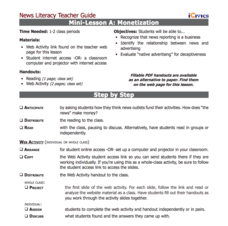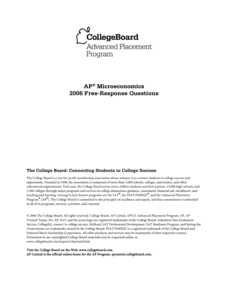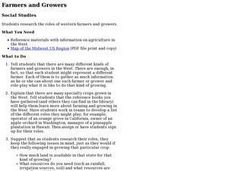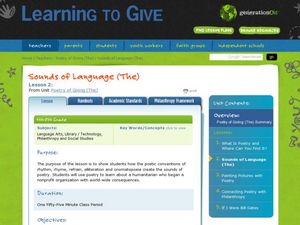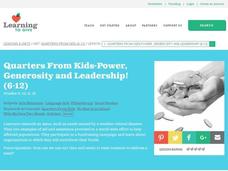Council for Economic Education
Teaching Economics Using Children's Literature
Introduce young learners to the subject of economics using their favorite stories and books. Including 24 separate lessons, this guide covers economic principles such as trade, scarcity, consumer goods and services, renewable and...
iCivics
Mini Lesson A: Monetization
Advertising is everywhere! Does your class know that their attention span is for sale, even when they're watching a simple news story? The second installment in a five-part series from iCivics examines the relationship between news...
College Board
2018 AP® Microeconomics Free-Response Questions
How much should Nirali study for her history and economics exams if she has a limited amount of time for both? Scholars consider opportunity cost in using this real-world scenario from College Board. Other questions include looking at a...
iCivics
Step Four: Working with Websites
Almost every profession today relates to websites in some way! The resource tasks the class to fill out three individual graphic organizers to help them analyze each website they visit.
College Board
2013 AP® Microeconomics Free-Response Questions
People often set off fireworks to celebrate. What is the cost of the annoyance of their neighbors? Economics help answer that question! Learners consider this problem, along with prompts on price and competition, using College Board...
College Board
2006 AP® Microeconomics Free-Response Questions
Communities often experience a tug-of-war between a desire for open space and a need for development. How can governmental policy affect each side of the issue? Scholars consider the question, along with queries on pricing and...
College Board
2009 AP® Microeconomics Free-Response Questions Form B
Two transportation companies must decide the best way to compete. How will that decision affect their prices? Using College Board materials, future test takers examine the problem and think critically to solve it. Other prompts examine...
College Board
2004 AP® Microeconomics Free-Response Questions
All goods have a social cost. A set of questions considers how to best calculate the impact the production of goods has on society. Other practice problems from College Board consider supply-and-demand curves and the impact of licensing...
College Board
2003 AP® Microeconomics Free-Response Questions Form B
How are monopolies and competitive firms similar and different? Scholars consider the question using authentic College Board materials. Other prompts consider supply and demand curves and the relationship between wages and output.
Radford University
Exploring Coal Pillar Mining
Coal mines can be a gold mine of math applications. After reading some basic information on coal mining, learners draw blueprints of a coal pillar in the shape of a composite figure. They find the volume of material from the coal pillar...
Smithsonian Institution
Strength in Solidarity: Coalition of Immokalee Workers and the Campaign for Fair Food
Not all food is created equal. The lesson dives into the world of migrant farm workers to show their struggles to earn livable wages and better working conditions. Academics learn why the Coalition of Immokalee Workers was created and...
Utah Education Network (UEN)
Extending the Number System
Don't feel negative about negative numbers. Individuals extend their knowledge of positive numbers and fractions to rational numbers. They see how to represent negative rational numbers on a number line, learn about opposites and...
Curated OER
Providing Service for a Nonprofit
Learners participate in a non-profit organization. In this citizenship lesson plan, students volunteer at a non-profit organization and apply the concept of philanthropy. Learners reflect upon their experience.
Curated OER
Is Capitalism Good for the Poor? | How Incentives Affect Innovation
Learners focus on the role played by a nation's institutions in generating creativity, invention and innovation, and analyzes how innovation promotes the economic growth that raises standards of living and alleviates poverty.
Curated OER
Farmers and Growers
Students explore the lives and work of the farmers and growers of specialty crops of the West. The amount of land and natural resources needed, the fertilizers utilized, and the market available for the crops are investigated in this...
Curated OER
Sale Price
In this mathematics worksheet, students identify how to find a sale price depending on what is being asked. They read a table that shows the cost and selling prices and complete the table to one decimal point. Then, students complete...
Curated OER
Day in the Life of a Nonprofit (A)
Young scholars interview a representative from a local nonprofit organization and share the learned information with the class. Each group gives basic information regarding the work of the nonprofit, then speaks to the class about some...
Curated OER
The Great Paper Airplane Factory
Young scholars investigate the economics of starting a business in this series of lessons. They role play parts of a business organization that sells paper airplanes making decisions based on calculations to make the most profitable...
Curated OER
How Fair is International Trade?
High schoolers research the concept of transnational corporations and investigate the details of one particular TNC. They then compare the Gross National Products of a range of countries to the profits of the TNCs.
Curated OER
Oklahoma Wheat on the World Market
Sixth graders explore profit and loss in the wheat trading market. In this sixth grade mathematics instructional activity/social studies instructional activity, 6th graders play a “Wheat Market Trading Game” in order to investigate...
Curated OER
Where Should They Hold the Fundraising Party?
Pupils explore financial applications of linear functions. As they investigate the steps necessary to plan a fundraising event, learners explore minimizing cost and maximizing profits.
Curated OER
The Poetry of Giving
Learn about philanthropy and poetic conventions with an inclusive lesson about Bill Gates. After learning about Mr. Gates' humanitarian efforts in the world, sixth graders use alliteration, onomatopoeia, rhyme, rhythm, and refrain in...
Curated OER
Quarters From Kids-Power, Generosity and Leadership
Students explore the concept of philanthropy. In this service learning instructional activity, students discover non-profit organizations that send relief in the wake of natural disasters. Students organize a fund drive to support an...
Curated OER
Understanding Fair Trade
Fourth graders investigate the idea that anyone who works hard makes a lot of money. In this cocoa farming activity, 4th graders understand the processes involved in cocoa farming and the profits gained by doing it.
Other popular searches
- For Profit Organizations
- Not for Profit Organisations
- Not for Profit Organizations
- For Profit Orginizatons
- For Profit Orinizatons

